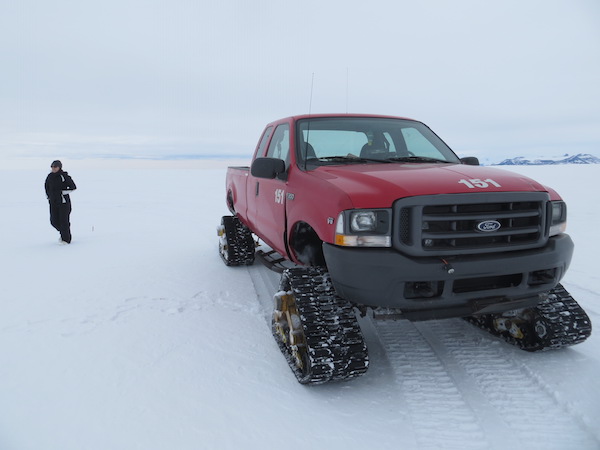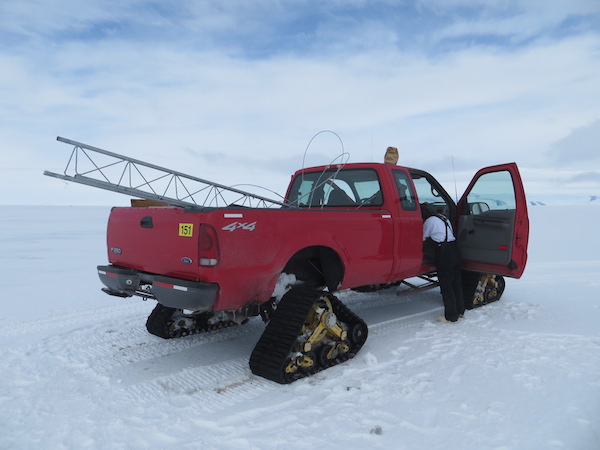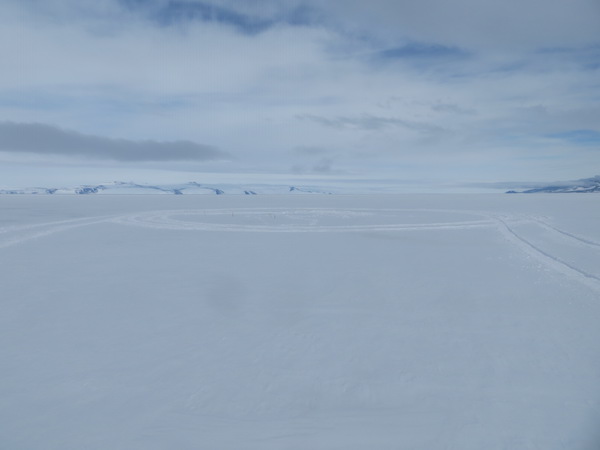It is long overdue that I give you all an update on our goings on in McMurdo. It’s 19 December, and since the last update I’ve given, the weather has been poor, then pretty good for a few days, and then somewhat poor again. We made it out to Pegasus North AWS on 15 December and Lorne AWS on 16 December, but other than that we have consistently been cancelled due to weather or priority. On our cancelled days, we’ve been able to prepare our cargo that we are bringing to West Antarctic Ice Sheet field camp (WAIS). This week, we have started putting the WAIS cargo into the system so it can be sent out to camp with us. Our goal is to get out to WAIS this Friday, 22 December (which is a few days ahead of schedule (which is unheard of for WAIS!)).
Between our helo visit to Pegasus North and Linda (back when Carol was still in town!) we went a full week of weather and priority cancellations. Carol left just in time: the day after she redeployed back home, a weather system brought in snow, wind, clouds, and low visibility for the next 4 or 5 days. All flights were at a standstill. LC-130 flights, aimed at bringing more pax (passengers) home, were delayed for the duration of the storm. Our Twin Otter and helo flights were also cancelled. These were trying times. As an homage to the repeated weather delays, the movie Groundhog Day was played on TV, on one of two channels that play one movie repeatedly all day. If you’re unfamiliar with the movie, the general premise is that the main character gets stuck reliving Groundhog Day over and over and over again. It was very fitting with the weather delays.
With all this downtime, Marian and I had the opportunity to organize our cargo to be sent to WAIS. We had to get instrumentation organized and ready for Evans Knoll, Thurston Island, and Harry. We also wanted to get another power system built to bring out there, since we will be replacing at least one power system (Austin). It’s always nice to have backups. After the more obvious equipment was packed, we organized all the tools we have available so that both AWS teams (me and Marian, and Matt Lazzara and Andy Kurth who will be coming to McMurdo in January) can still do field work from their respective locations (WAIS for me and Marian, McMurdo for Matt and Andy). Also as a note, this is Matt’s first deployment in many years! It’s been all the talk around town that he will be coming back to McMurdo. Everyone is excited!
On 15 December, weather was finally starting to improve. We were on the Otter and helo schedule, and naturally we were cancelled on Otter. We haven’t been able to be primary on any Otter missions since this Otter is with the New Zealand Antarctic Program, not the US Antarctic Program. That makes it less likely that we will fly, but it’s nice that they put us on the schedule anyways. We were weather delayed on helo, but we figured that delay would inevitably turn into a cancellation, so we took fate into our own hands and said no thank you, we will drive out to Pegasus instead. So we took a Mattraks out to Pegasus Airfield to remove Pegasus North.
We needed to take the Mattraks because we would be driving on an un-groomed road (unsuitable for tired vehicles). Pegasus Airfield is no longer running, so they don’t groom the roads to it. It is a couple miles past the newly opened Phoenix Airfield, so those last two miles were really the only ones we were worried about. It’s slow going with the Mattraks, but we brought some of our music along to help the 1 hour, 15 minute drive go by just like that. When we arrived, we were not surprised to see the AWS did not right itself.
We began our work and removed the instrumentation and power system first.
Next, we needed to dig/ice pick our way down a couple feet to free the guy wires and tower base, which were frozen into the snow/ice. I was expecting this process to take much longer than it did, and after a little over two hours of ground time we had removed Pegasus North.
The next day, we went to Lorne to raise the lower instrumentation and troubleshoot issues we have been having with the Freewave modem at the site. In March 2017, transmissions clicked off unexpectedly at Lorne. Our working hypothesis was that somehow the IP address was reset to its default, which would mean it would not be able to communicate with the repeater site, White Island, to send data back to McMurdo.
While I was troubleshooting the modem issues, Marian and our boondoggler Kristy dug out the power system. From Carol and George’s earlier visit, they had reported that it was very difficult to get the power system to budge from it’s hole even a little bit. They also reported a lot of icing around the power system itself. With those notes, we were worried that it would take a lot of digging and ice picking to free the power system. Overall, I think it went much more smoothly than we were anticipating. Marian and Kristy did a great job of digging the 3 to 4 feet down to get the power out of its hole and up to the surface.
While they were succeeding, I was not. I attempted to communicate with the modem via the laptop, but the several methods I tried did not work. Eventually, and after much discussion with Lee back in Wisconsin on the Iridium satellite phone, I decided to take the modem back to the lab to troubleshoot it there. As it turns out, despite the modem indicating it gets power, the ports do not turn on, so it can’t send any data. That was unfortunate to discover, as it means we will need to visit Lorne again, but at least we were able to raise the power system and lower instrumentation.
We are on the helo schedule today to fly to Linda to install the Paroscientific pressure sensor recovered from Pegasus North, but the weather appears like it will not cooperate. Regardless, we hope to finish getting the rest of our WAIS cargo into the system and take care of a few loose ends. We are now approaching the time when we will be trying to take an LC-130 to WAIS, which can always be an adventure. I’ll send updates with that when I can!
Cheers,
Dave











